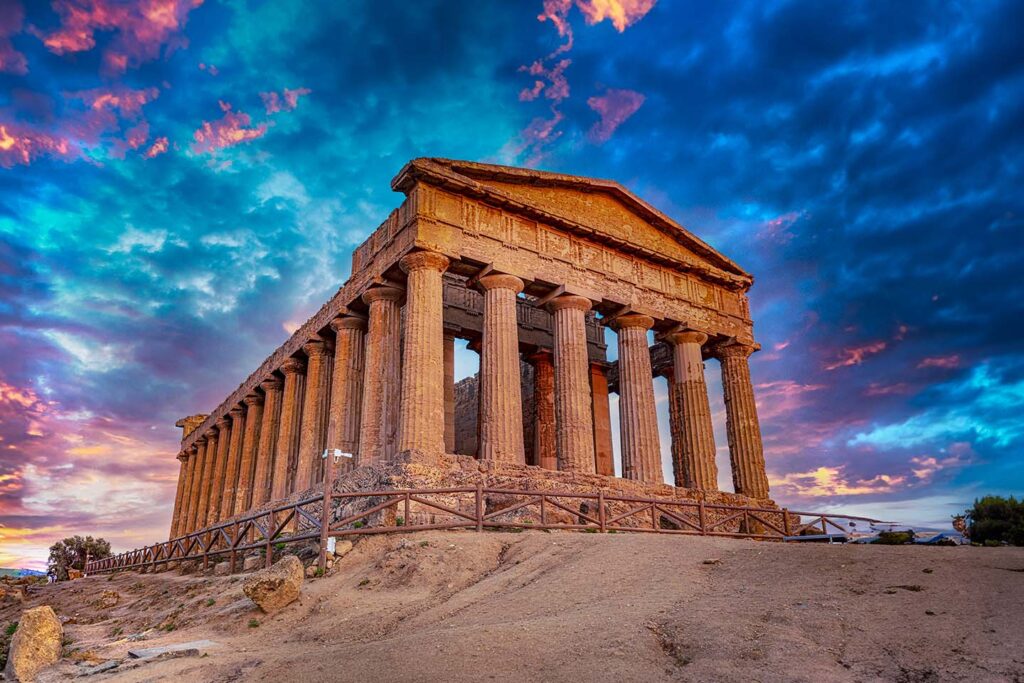An exploration of Nature, culture, and Beauty

Our exclusive private car tours will lead you to the discovery of breathtaking landscapes, archaeological sites rich in history, and unforgettable panoramas.
The Valley of the Temples is not actually a valley, but a hilltop ridge where ancient Akragas, one of the most important cities of Magna Graecia (Greater Greece), once stood. Today, it is an archaeological area of approximately 1300 hectares that preserves monumental remains of Doric temples, necropolises, sanctuaries, and
hydraulic works.
What to see Valle dei Templi
- Temple of Concordia: Considered one of the best-preserved Doric temples in the world. Its elegant architecture and the harmony of its proportions make it a masterpiece of 5th-century BC Greek art. It owes its name to a Latin inscription found nearby, although it is not directly connected to the temple.
- Temple of Juno (Hera Lacinia): Located on the eastern part of the hill, it offers a panoramic view of the valley. Built around the 5th century BC, it still has several standing columns. It was dedicated to Hera (Juno for the Romans), the goddess of marriage and family.
- Temple of Heracles (Hercules): The oldest of the temples in the Valley, dating back to the end of the 6th century BC. Today, only eight columns remain standing on the south side. It was dedicated to the Greek hero Heracles (Hercules for the Romans), a symbol of strength and courage.
- Temple of Olympian Zeus: One of the largest temples in the Greek world, although today it lies in ruins. Its construction, begun after the victory of Himera in 480 BC, was never completed in its original form. Impressive remains can still be admired, such as the Telamons, gigantic male statues that served as columns.
- Temple of the Dioscuri (Castor and Pollux): A symbol of the Valley of the Temples, although only four columns and part of the pediment have been reconstructed in modern times. The temple, dating back to the 5th century BC, was dedicated to the divine twins Castor and Pollux.
Must-see attractions
- Sanctuary of the Chthonic Deities: A sacred area dedicated to deities associated with the earth and fertility, such as Demeter and Persephone. Remains of altars and small temples can be observed.
- Paleochristian Necropolis: An extensive burial area with tombs and sarcophagi dating back to the Paleochristian and Byzantine periods, evidence of the continuity of life in the area after the end of the Greek and Roman eras.
- Garden of Kolymbetra: An oasis of greenery nestled among the temples, once a water basin from the Greek period. Today, it is a lush garden with citrus groves, olive trees, and Mediterranean plants, managed by the FAI (Italian Environment Fund).
What to see Piazza Armerina
- Villa Romana del Casale: This UNESCO World Heritage site is an exceptionally well-preserved Roman villa dating back to the 4th century AD. Its stunning collection of intricate and colorful mosaics is considered the finest of its kind in the world, depicting scenes of daily life, mythology, hunting, and even the famous “bikini girls.”
- The Aragonese Castle: Built in the late 14th century, this castle offers a glimpse into the town’s medieval past.
- The Archaeological Museum: Located near Piazza Garibaldi, this museum houses finds from the Villa Romana del Casale and other archaeological sites in the area, providing further context to the region’s history.
- Via Monte: This is considered the oldest street in town and is lined with beautiful Baroque palaces.
- Chiesa di San Martino: One of the oldest churches in Piazza Armerina, dating back to 1163
What is not included in the tour
- Tickets to the different sites and museums
- A private guide
Price
Max 4 pax da 360 € – FULL DAY
